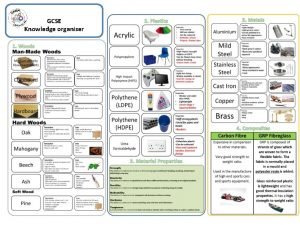GCSE Knowledge Organiser The Cold War in the


- Slides: 2

GCSE Knowledge Organiser: The Cold War in the 1940 s. Key Events Key Words 1 1945 Yalta and Potsdam Conferences: discussion involves what to do with Germany to prevent war and to maintain peace in Europe. Cold War Term used to describe the tensions between the Soviet Union and the West 1945 -1991 2 1945 Atom bombs are dropped by USA on the Japanese cities of Hiroshima and Nagasaki leading to the end of WWII. Capitalism The economic system followed by the West during the Cold war. People have the right to start/own businesses in a free market. 3 194547 Soviet Expansion into Eastern Europe begins as the Red Army remains in eastern European countries that have been liberated from Nazi control. Communist governments are installed as opponents are executed and elections are rigged. Communism An economic and political system in which there is no private ownership, people contribute based on their ability and take only what they need. 4 1946 ‘The Iron curtain’ speech is made by Winston Churchill to warn of advancing Communism in Eastern Europe. Eastern bloc Group of countries in Eastern Europe that were allied because of shared interests during the Cold War. 5 1947 The Truman Doctrine promises to prevent the spread of Communism through American support, leading to the establishment of Soviet Cominform in retaliation. Democracy A system of government where citizens elect their leaders or have a say in their country’s laws. 6 1948 The Marshall Plan is launched to help countries in Europe recover from WWII. $13. 5 million is divided between 16 countries. Soviet sphere of influence The Soviet Union would have countries under its ‘influence’ after the Second World war as a way of guaranteeing security. 7 19489 Berlin Blockade and Airlift reflects the increased tension between East and West and proves containment is working. Free elections All political parties have an equal right to contest the elections, campaign for voter support, hold meetings and rallies. The voter has the right to vote in secret. 8 1949 North Atlantic Treaty Organisation (NATO) is established with 12 countries promising to protect Western Europe against outside threats. Iron Curtain Name given by Winston Churchill to describe the boundary dividing Europe into two separate areas, the Eastern bloc and the West, from 1945 to the end of the Cold War Truman Doctrine A set promises made by Truman to provide military and economic aid to Greece and Turkey and any country threatened by Communism. Congress The American parliament Containment A Cold war foreign policy of USA. The aim was to prevent the further spread of Communism by containing it to its existing areas. Cominform Communist Information Bureau. Created to bring unity to communist countries behind the iron curtain. Members met regularly so Stalin could ensure the countries were following the same policies. Marshall Plan Economic recovery programme, launched by US Secretary of State, George Marshall to provide funds for European countries to rebuild after the end of WWII. Dollar Imperialism The Soviet idea that the USA spreads its influence and power around the world using money Comecon Soviet version of Marshall Aid. Aim was to provide support and bring economic stability to Eastern European countries. 9 1949 Communism is established in China , led by Mao Tse-tung, exiling Chiang Kai-shek’s nationalist government to Taiwan. Communism has spread to Asia. Key People Joseph Stalin Winston Churchill Clement Attlee Harry S Truman Leader of the Soviet Union 1922 -1953. Wanted to secure Soviet security after two world wars. Much less willing to compromise with Truman over the future of Europe after the dropping of the atom bombs which British Prime Minister 1940 -45 and again 1951 -55. Saw the need for a close relationship with USA after WWII had ended. Anti-communist, wanted to look after British interests and limit Soviet expansion. British Prime Minister 1945 -1951. Also concerned about USSR’s expansion into Eastern Europe. He saw it as vital to stay close to the USA in the face of growing Soviet power. President of America 1945 -53. Unfriendly relationship with Stalin. Concerned about growing Soviet power in Eastern Europe, was willing to use force to achieve America’s aims.

GCSE Knowledge Organiser: The Cold War in the 1940 s. Key Events Key Words 1 1945 Yalta and Potsdam Conferences: 2 1945 Atom bombs 3 194547 Soviet Expansion into Eastern Europe 4 1946 ‘The Iron curtain’ speech is made Eastern bloc Group of countries in Eastern Europe that were allied because of shared interests during the Cold War. 5 1947 The Truman Doctrine Democracy A system of government where citizens elect their leaders or have a say in their country’s laws. 6 1948 The Marshall Plan Soviet sphere of influence 7 19489 Berlin Blockade and Airlift 8 1949 North Atlantic Treaty Organisation (NATO) is established with 12 countries promising to protect Western Europe against outside threats. 9 1949 Communism is established in China , led by Mao Tse-tung, exiling Chiang Kai-shek’s nationalist government to Taiwan. Communism has spread to Asia. Cold War Capitalism Communism Free elections Key People Iron Curtain Truman Doctrine Congress The American parliament Containment Cominform Joseph Stalin Winston Churchill Clement Attlee Harry S Truman Marshall Plan Economic recovery programme, launched by US Secretary of State, George Marshall to provide funds for European countries to rebuild after the end of WWII. Dollar Imperialism The Soviet idea that the USA spreads its influence and power around the world using money Comecon Soviet version of Marshall Aid. Aim was to provide support and bring economic stability to Eastern European countries.



